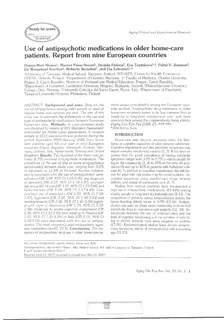| dc.description.abstract | BACKGROUND AND AIMS: Data on the use of antipsychotics among older people in need of regular home care services are rare. The aim of this study was to ascertain the differences in the use and type of antipsychotic medications between European home-care sites. METHODS: A cross-sectional study was designed by means of RAI (Resident Assessment Instrument for Home Care) assessments. A random sample of 3251 assessments was gathered during the period September 2001-January 2002 from home care patients aged 65 and over in nine European countries (Czech Republic, Denmark, Finland, Germany, Iceland, Italy, Netherlands, Norway and United Kingdom). RESULTS: Two hundred of the home care patients (6.2%) received antipsychotic medication. The prevalence of the use of one or more antipsychotics varied widely between study sites, ranging from 3.0% in Denmark to 12.4% in Finland. Factors independently associated with the use of antipsychotics were: delusions (OR 3.09, 95% CI 1.66-5.76), any diagnosis of dementia (OR 2.57, 95% CI 1.70-3.87), youngest age group (65-74 yrs) (OR 2.37, 95% CI 1.53-3.66) and hallucinations (OR 2.28, 95% CI 1.17-4.45). Concomitant use of anxiolytics (OR 2.32, 95% CI 1.58- 3.41), hypnotics (OR 2.08, 95% CI 1.44-3.03) and antidepressants (OR 2.06, 95% CI 1.41-3.00) together with signs of depression (OR 1.78, 95% CI 1.24- 2.56), moderate to severe cognitive impairment (OR 1.30, 95% CI 1.12-1.51) and residing in Finland (OR 2.52, 95% CI 1.21-5.24) or Italy (OR 2.15, 95% CI 1.10-4.19) were associated with the use of antipsychotics. The most commonly used antipsychotic agent was risperidone (n=42, 21%). CONCLUSIONS: The frequency of antipsychotic drug use in older home-care patients varied considerably among the European countries studied. Antipsychotic drug treatment in older home-care recipients seems to be less common than in residents in long-term institutional care, and more common than among the independently-living elderly. | en |
